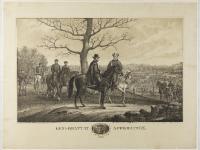1865 was a watershed year for many people as they were impacted by the surrender at Appomattox, the assassination of Lincoln, the passage of the 13th Amendment, and the setting up of new organizations to help "freedman" and soldiers adjust to post-war life. HSP just put on display some fascinating items from its collection related to these themes.The display runs through April 17 and is free during public hours.
One of the special features of the display is a collection of eyewitness accounts. There are letters and diaries from soldiers and civilians, and even the conductor of Lincoln's funeral train. These writings humanize past events - with sadness and humor - and can bring the past alive for your students.
To help students and teachers access this material, HSP has also added an online component to the display. 1865 - Eyewitness to History contains nine transcriptions. Read how Lee looked on the day of surrender or how a frustrated Confederate General struggled with an oath to the Union. Learn about items not found in traditional textbooks, such as how a soldier adopts a dog and husbands rail at wives for not writing.
These letters are the perfect vehicle for teaching social studies - what can one learn from eyewitness accounts that adds to what is learned from the textbook? - but also for using history to teach Language Arts. Check out the vocabulary, syntax, and point-of-view. Have students write their own letters about current events and compare how they each may see an event differently. What do they include? Exclude? By extension, the students may discuss how the move to email and social media changed the nature of the conversation. Can they write a tweet that summarizes each letter? What is lost or gained?
So come by and see the display if you are nearby, bring a class, or use the letters in the classroom.

